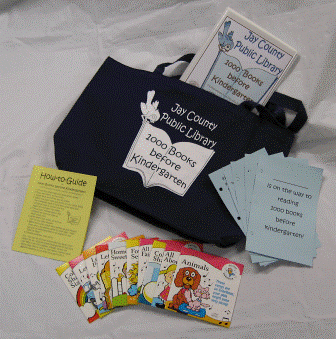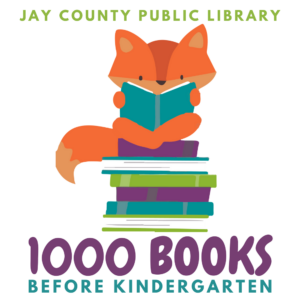Join the library’s free program to help
your preschooler get ready to read!
Enjoy books together now and reap benefits as your child gains skills that will prepare him or her for learning to read independently.
Every child enrolled in the program receives a canvas book bag for toting all those great stories, a notebook for recording the titles they read. Folders with book lists and ideas for parents are included in the notebook.
Support for the 1000 Books Before Kindergarten program comes from the Friends of the Jay County Public Library and through funds from
the library’s endowment with The Portland Foundation.

How it works
- Once you’ve registered, fill up your book bag with some great books!
- Read to your child often and write the book titles in your notebook.
- When you have read 100 books to your child, bring the notebook and your child to the library, and we’ll give them a sticker and the pages for the next 100 titles.
- After every 100 titles, visit the library to pick up the next packet.
- When your child reaches 1000 books, he/she will receive a hardcover book to keep. They will also be photographed to appear on our “Wall of Fame”!
You can do this for every child in your family, from infant up to kindergarten.
If your child is entering kindergarten soon, you may need to read 6 books or more a day to finish by the first day of school. The gain of skills is so important, it’s worth it. You may be surprised by how quickly it goes!
Frequently Asked Questions
Can you really expect to read 1000 books to your child before kindergarten?
If you read only one bedtime story every night for three years you will have read 1095!
If you read 10 books each week for two years, you will have read 1040.
Double that rate to do 1000 books in one year.
You can begin much earlier though, when your child is an infant!
Count any books that are read to your child, no matter who reads the books. It can be a brother, sister, grandparent, babysitter, teacher, etc. As long as they hear the entire story, you can count it.
Do we have to read books from Jay County Public Library?
No, you can read books from anywhere – your home, the doctor’s office, preschool, Grandma’s house, other libraries.
I read the same story every night to my child. Can I count that book more than once?
Yes, write down the title each and every time you read the book.
I have more than one child I read to. Can I count the same title for each child?
Of course you can!
Can I count books read at library Story Times? How about books that my preschooler hears at school from the library’s visiting story person and the preschool teachers?
Yes, just ask for the titles.
My child has an electronic game (or a computer game) that reads the story. Can I count that? What about books on CD?
As long as your child listens to the entire story, you can count either. Please don’t count it if your child just plays the games.
My child “reads” books to himself. Should I count those?
While it’s a great start to reading, if your child is only pretending to read, you shouldn’t count it for this project. If your child has memorized a book you read together frequently and can read it themselves, then go ahead and count it.
Every Child Ready to Read At Your library!
You are your child’s first and most important teacher! You know your child best and can work with them at times when they are in the mood to learn.
What you do helps your child get ready to read. There are six pre-reading skills that children must have in order to learn to read. You can practice these skills with your child at any age, from infant on up, adapting it to their age.
Narrative Skills
What it is: Being able to describe things and events and tell stories
What you can do: Tell stories to your child. Have them tell you stories. Practice what happens first, next, and last. Relate what is going on in the story to something similar you have done.
Phonological Awareness
What it is: Being able to hear and play with the smaller sounds in words.
What you can do: Play rhyming games. Ask, “Do cat and dog rhyme? Do cat and hat rhyme?” Sing songs and clap out the syllables in the words. Put two words together – “What if we put hot and dog together?” And take them apart – “What would you have if we took cow away from cowboy?”
Print Motivation
What it is: Being interested in and enjoying books.
What you can do: Make book sharing a special time. Let your child see you read. Visit your library often. Let your child know that you value reading in your daily life.
Vocabulary
What it is: Knowing the names of things.
What you can do: Talk with your child about what’s going on around you. Point at and identify everyday items as you encounter them. Add more details to things your child tells you. Read together every day! Research shows that children who have larger vocabularies are better readers.
Print Awareness
What it is: Noticing print, knowing how to handle a book and knowing how to follow the words on a page.
What you can do: Read aloud everyday print – labels, signs, lists, menus. Let your child hold the book and turn the pages. Hold a book upside down and see if your child notices.
Letter Knowledge
What it is: Knowing letters are different from each other, knowing their names and sounds and recognizing letters everywhere.
What you can do: Write your child’s name. Make letters from clay. Play with magnetic letters. Read alphabet books and point out the letters. Show your child that the same letter can look different.

